Earlier, we gave you guys a brief overview of some of the Cherry Mobile Ultra’s features and gave you a quick tour of its simple yet well-put-together body. Now it’s time to delve deeper into this LTE smartphone to see what other things its got to offer besides good looks and LTE functionality.
Design and Construction
When we’re looking at the CM Ultra head on, we can’t help but notice a faint resemblance between the handset’s design and that of the Blackberry Z10. At first we thought that the similarity was only skin deep, but as soon as we picked the handset up, it also felt very similar to the hands as Blackberry’s first BB10-powered full-touchscreen handset.
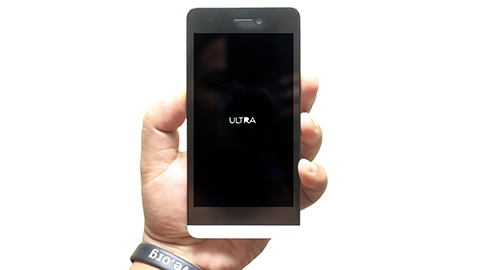
One of the few differences between the two devices, design-wise, is the placement of the buttons and external components. The power button of the CM Ultra is located at the right side, while the Micro-USB port is placed at the bottom, and is slightly off-center.
Meanwhile, the volume rocker occupies the left flank of the CM Ultra and the audio port is situated at the portion of the device, below its white-colored chin that gave it a slight similarity with the Z10’s façade.

The CM Ultra’s 13MP snapper is smacked in the top-center portion of its posterior, and is accompanied by a tiny LED flash. On the other end of the pole is where speaker grilles are located with a “Cherry Mobile” logo above.
Underneath the removable back lies the Ultra’s 2000mAh battery pack which is neighbored by a pair of slots for a Micro-SIM card and a Micro-SD card.
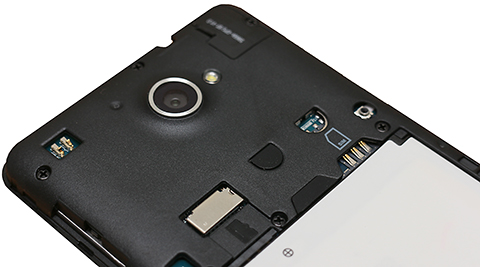
All in all, we think that the Cherry Mobile Ultra is one of the more decent looking handsets that local company has rebranded. We really like the smartphone’s minimalist design and it feels very nice to the touch despite being a little hefty.
But not only does the Ultra look good, it also gives a sense of durability thanks to the material used in crafting its body. It’s not the thinnest, nor the most bad-ass looking smartphone out there, but we think that it has enough allure to woo even the most nitpicky consumer.
Display and Multimedia
One of the advantages that the CM Ultra has over the W900 LTE is its screen. Although both devices share the same 1280×720 resolution, consumers will definitely appreciate the extra real estate that the Ultra has to offer.
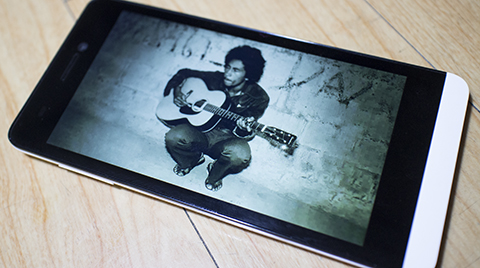
Despite of not having a full-HD display, which is something we’ve come to expect from flagship devices nowadays, the CM Ultra’s display is still very decent and offers good viewing angles thanks to its IPS panel. Outdoor legibility and color reproduction was ok. Nothing really groundbreaking, but certainly not the worse out there.
Unfortunately, unlike its display, the sound coming out of its built-in speaker leaves a lot to be desired. Even if we cranked up the volume to it highest, we still usually find ourselves cupping the back of the phone just to hear the sound that we’re trying to listen to. Moreover, overall quality was also muddy at best and you’re probably better off putting on a pair of headphones/earphones if you’re planning of using this device as a media player.
OS, UI and Apps
The Cherry Mobile Ultra ships with Android Jellybean. As usual, the company applied their own set of customizations to the OS to differentiate it from other Android handsets in the market.
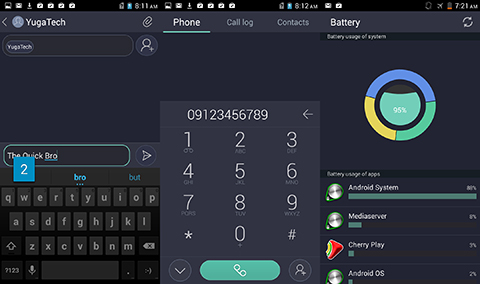
CM has once again used the Start by Celltick, which we first saw on the Flare HD, for the Ultra’s lock screen. The company also applied the same subtle changes on some of the native apps like the Dialer and Messaging we’ve seen on some of the more recent handsets that CM released.
In most cases, the CM Ultra didn’t have any troubles in loading/handling apps, whether pre-installed or third party. There are, of course, some rare instances that apps force closes and/or doesn’t initialize properly, but nothing really alarming to raise a red flag.
Performance and Benchmark
Unlike most budget smartphones that Cherry Mobile released, the CM Ultra is actually one of the few handsets that are equipped with a Snapdragon processor. More than just the performance aspect, some of Qualcomm’s entry-level/mid-tier processors have something that even MediaTek’s current chipsets don’t, an LTE chip. So unless the new MT6595 starts popping up on budget smartphones, we think that Qualcomm will continue to dominate in this category.

LTE aside, we noticed a more consistent performance from Snapdragon 400 processor of the CM Ultra compared to MediaTek-powered Cherry Mobile smartphones we’ve reviewed recently. Qualcomm’s chipset also fared better in the benchmark tests compared to smartphones with MediaTek processors.

AnTuTu: 17,594
Quadrant Standard: 8,417
NenaMark 2: 56.9fps
Vellamo: 1574 (HTML5) / 706 (Metal)
Despite being only a mid-tier processor, the Snapdragon 400 actually performed pretty darn well on most occasions; multi-tasking was a breeze and graphics-heavy games like Asphalt 8 was relatively lag-free even on max settings.
The only thing that the CM Ultra, or the Snapdragon 400 for that matter, seems struggled with is taking successive pictures. It takes roughly around 2-4 seconds before you can take another picture using the native camera app. We’re not exactly sure if the Snapdragon 400 is the culprit here or it’s just a software-based issue, though we’re inclined to believe that it’s the latter.
Camera
Despite the handset’s inability to take pictures in quick successions, the images we took using the CM Ultra’s 8MP rear camera were actually quite good. The pictures have a decent amount of sharpness and the contrast is also on the positive side.
[fancygallery id=”99″ album=”103″]
One thing we didn’t like about it was its autofocus. We weren’t able to select the area we want the camera to focus on unlike with other smartphones. Instead, it only focuses on the center which forces users to recompose most of their shots if they want to be a little creative with their compositions.
Connectivity and Call Quality
One of the things that made the Cherry Mobile Ultra quite the head-turner is the fact that it’s probably one of the cheapest LTE-enabled smartphones currently in the market. The CM Ultra, which is only being sold for Php8,999USD 153INR 13,000EUR 146CNY 1,117, is a huge step up from the W900 LTE which was initially being retailed for Php11,490USD 196INR 16,598EUR 186CNY 1,426 when it first made its debut.
To get a good feel of its LTE prowess, we tested both Globe and Smart LTE SIM cards on the CM Ultra. True enough, the handset was able to connect to both telco’s LTE connection almost seamlessly and was able to detect LTE signal whenever it’s available.
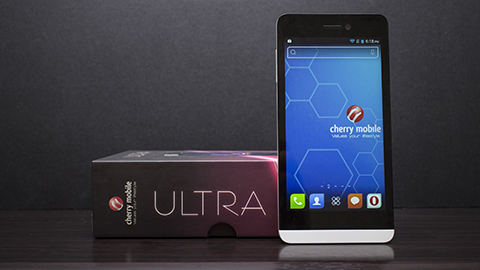
As for the quality of voice calls, let’s just say that we really didn’t have that much problem in this area. Apart from a few dropped calls, which we think is more network-related problem than the phone itself, we have no issues receiving/making calls using the CM Ultra and our voices were clearly heard by the people we’ve talked over the phone.
Battery life
When you look at the CM Ultra’s specs sheet, its 2000mAh battery pack may seem a bit underwhelming considering the things that it needs to power up. However, that was certainly not the case when performed our usual video loop test on the handset.
On a single full charge, the CM Ultra lasted for a little over six hours and forty minutes (6:40) during our battery test which was pretty impressive given the relatively low capacity of its battery. Unfortunately, we can’t show the details of the mileage we got during our test because of Cherry Mobile changed the battery status under Settings.
Conclusion
Despite of a few minor shortcomings, we think that the Cherry Mobile Ultra is one of the best bang-for-the-buck smartphones in the market.
Cherry Mobile Ultra specs:
5-inch HD IPS display, 1280×720 @293ppi
1.2GHz Snapdragon 400 MSM8926 quad-core processor
Adreno 305 GPU
1GB RAM
Expandable 8GB internal memory
13MP BSI rear camera with LED flash
1080p video recording @30fps
2MP front-facing camera
LTE, HSPA
WiFi 802.11 b/g/n, DLNA, Wi-Fi Hotspot
Bluetooth 4.0 LE
FM Radio
GPS w/ A-GPS, GLONASS
Single SIM (Micro)
Android 4.3 Jellybean
2,000mAh battery
Dimension: 145.5 x 72.5 x 9 .0mm
Weight: 162g
Price: Php8,999USD 153INR 13,000EUR 146CNY 1,117
It’s got great looks to match its respectable specs sheet and its got LTE connectivity in tow which is certainly a huge plus for consumers who have LTE coverage in their area. Furthermore, its seemingly modest battery pack surpassed even our wildest estimate, thanks to its super-efficient Snapdragon 400 processor.
What we liked about it:
* Uncluttered design and durable make
* Decent display
* Relatively snappy performance
* Good battery life
* LTE
* Affordable
What we didn’t like about it:
* Poor audio output from the speaker
* Slow camera
* Center-only autofocus
* Single-SIM only

YugaTech.com is the largest and longest-running technology site in the Philippines. Originally established in October 2002, the site was transformed into a full-fledged technology platform in 2005.
How to transfer, withdraw money from PayPal to GCash
Prices of Starlink satellite in the Philippines
Install Google GBox to Huawei smartphones
Pag-IBIG MP2 online application
How to check PhilHealth contributions online
How to find your SIM card serial number
Globe, PLDT, Converge, Sky: Unli fiber internet plans compared
10 biggest games in the Google Play Store
LTO periodic medical exam for 10-year licenses
Netflix codes to unlock hidden TV shows, movies
Apple, Asus, Cherry Mobile, Huawei, LG, Nokia, Oppo, Samsung, Sony, Vivo, Xiaomi, Lenovo, Infinix Mobile, Pocophone, Honor, iPhone, OnePlus, Tecno, Realme, HTC, Gionee, Kata, IQ00, Redmi, Razer, CloudFone, Motorola, Panasonic, TCL, Wiko
Best Android smartphones between PHP 20,000 - 25,000
Smartphones under PHP 10,000 in the Philippines
Smartphones under PHP 12K Philippines
Best smartphones for kids under PHP 7,000
Smartphones under PHP 15,000 in the Philippines
Best Android smartphones between PHP 15,000 - 20,000
Smartphones under PHP 20,000 in the Philippines
Most affordable 5G phones in the Philippines under PHP 20K
5G smartphones in the Philippines under PHP 16K
Smartphone pricelist Philippines 2024
Smartphone pricelist Philippines 2023
Smartphone pricelist Philippines 2022
Smartphone pricelist Philippines 2021
Smartphone pricelist Philippines 2020
Justin says:
“What we didn’t like about it:
* Single-SIM only”
… Huh???
You didn’t like the phone since it did not have a dual-SIM feature? So… are you saying that you also dislike 90+% of the smartphones out in the market since they’re also “single-SIM only”.
I’ve always viewed the “dual-SIM” feature as a perk, and not something that MUST be on every smartphone, and most certainly not a valid criteria for disliking it.
Anal Nitpicker says:
Define valid.
And since CM sells 3 million phones a year, 90% of smartphones out there simply are not single sim. Unless you’re talking about those cheap Samsungs. Which I see less and less as the informed ones switch to the better valued local brands.
Justin says:
@Anal: OK, I’ll define valid by using examples. Take a look at the other disliked points by the author.
Speakers. Poor output. That’s valid. Camera. Slow performance. That’s valid. SIM. Poor performance? Slow? Malfunctioning? Flaws? Wala, diba? It just would have been better kung dual-SIM sya. Hence, it should have been categorized under a wish list.
Ronnie Bulaong says:
I’m not sure if you really understood our “What we didn’t like about it” section, but just to set things straight the section is intended to point out what features of the device we like/dislike.
As such, including the “Single-SIM only” under the didn’t like column doesn’t mean that we dislike the CM Ultra (or any handsets for that matter) just because it’s only a single-SIM device, rather we dislike the fact that it only has one SIM card slot and it would’ve been better if it had another one.
See the difference?
Justin says:
Yes, I see your point. Now see mine.
I’m simply stating that the SIM capability of any phone is not a valid criteria to be placed in your like/dislike section. Mentioning in your article that “Dual SIM functionality would be a plus” is fine.
After all, if we go with your point and if you want to be consistent, then you might as well also add “Dislike: Single-SIM only” bullets on all the single SIM phones you’ve reviewed in the past, as well as those you will review in the future.
Kami says:
well i guess i got @Justin’s point. it goes without saying that the author should have pointed “Having a dual-sim feature on his PREVIOUS REVIEWS in the LIKE section and single-sim only, on the DISLIKE section”.
on a more practical note, will the dual-sim functionality affect the battery performance of the Ultra?
then, having it single-sim is fine. and having it dual-sim would have put Poor Battery Life on the “what we didn’t like it” section…
just saying.
wew says:
nagaagree ako kay @Justin
lawrence says:
I totally understand @Justin’s point. If yugatech would be consistent, then on all reviews put dual-sim in the like portion and single-sim in the dislike section. For example, when yugatech reviewed Sony Xperia Z2, I didn’t see in the dislike portion “sindle-sim only”.
toriko says:
full specification is here: http://goo.gl/XM2oua
Tishy says:
Good afternoon! How do you take a screen shot sa Ultra? Thank you!
minideal.co says:
only problem is no updates…even the sms bug (sending = sign to lenovo phone will
cause reboot) is discovered, lenovo didnt bother to
fix it…u will be stuck with 4.1.1 forever unless root with custom rom
Alice says:
2000mAh ? fail . . .
Francis says:
is Globe capable on this device?
killerbytes says:
Even at a reduced price of 3,999, I still wont buy it.
jomari says:
I just saw this phone on lazada and i find it interesting cause for only 3999 i can avail a lte device